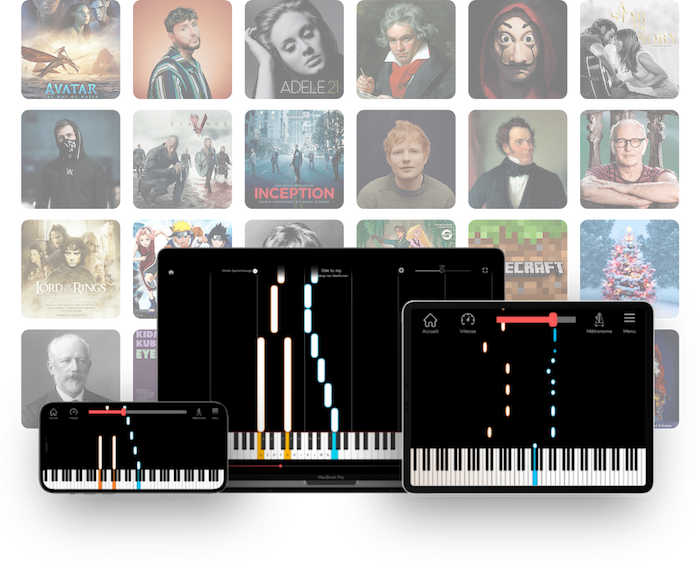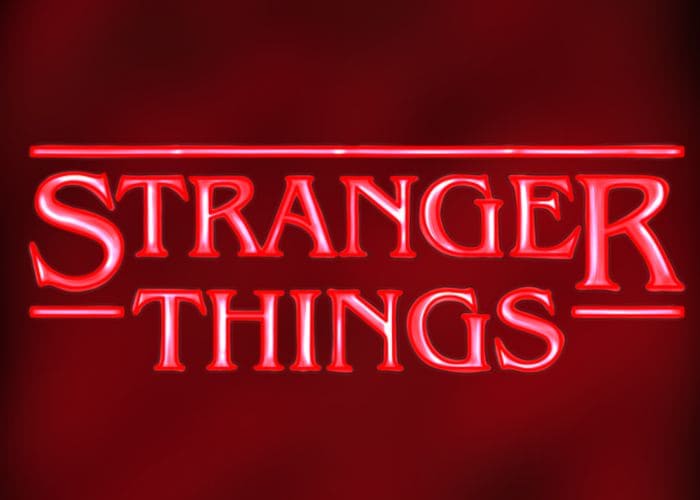
Would you like to learn how to play the notes of Running Up That Hill on the piano? Welcome to this tutorial!
Running Up That Hill is an iconic song from 1985, written and performed by British singer Kate Bush. It explores themes of human relationships and empathy, expressing the desire to understand the emotions of others. The song has been used in films, TV shows and commercials, including the Stranger Things series, for its atmospheric, dramatic mood.
On the piano, its captivating melody and rich chords make it a stimulating piece to play for pianists of all levels, offering opportunities for personal expression while remaining true to the essence of the song.
We’ll take you step by step through the notes of this famous song. We’ll start with the notes for the right hand, followed by those for the left. Finally, we’ll show you how to harmonize them for a hypnotic, captivating performance.
Once you’ve followed our tutorial, you’ll be ready to play Running Up That Hill on the piano with fluidity and confidence. So get to your keyboards, and let the music begin!
Bonus : you can also learn to play this song at your own pace on our interactive piano learning app La Touche Musicale.
Free download: >> >> The guide to learn 10 easy piano pieces.
Learn to play your favorite songs on the piano
The La Touche Musicale learning app offers more than 2,500 songs to play easily on the piano. Connect your piano to your device and learn to play them at your own pace while having fun.
Before we start learning Running Up That Hill, let’s take a moment to review the piano basics and familiarize ourselves with the keyboard. Here’s an illustration to help you along:

The name of the notes on a piano keyboard.
We’ll help you summarize the main information:
On a piano keyboard, each key represents a musical note. White and black keys alternate regularly. The white keys represent natural musical notes (C, D, E, etc.), while the black keys represent altered notes (C#, D#, etc.).
To locate a specific note, use the groups of black keys. There are groups of two or three black keys, which serve as visual cues. The note C is located on the white key to the left of a group of two black keys: it’s the reference note! From C onwards, you can easily identify the other notes, which always follow in the same order: D, E, F, G, A, B.
Sharp notes are represented by the black keys to the right of the corresponding white keys. For example, if you press the black key to the right of the white C key, you’ll play C sharp (or C#). Similarly, flats are located to the left of the corresponding white keys. For example, the black key to the left of the white D key is D flat (or D b).
Practicing your keyboard mapping will make it easier for you to play the notes you want!
We’ll start by learning the melody of this song, which is usually played with the right hand. The melody is the most recognizable part of a song, which makes it an ideal starting point.
So take the time to locate on your keyboard the first note of the Running Up That Hill melody to be played with your right hand: the note A#.

The note A# is the first note to be played with your right hand for the song Running Up That Hill on piano.
Have you managed to locate the first A# note of the song on your keyboard? Excellent! Now we can move on to all the other notes in the right hand.
Press each of these keys on your keyboard in turn:
A# – G – C – A# – G – C – A# – G – A# – C – A# – C – D# – A# – C – A# – C – G – F – D# – C – G – G – G – A# – G – C – D# – D – A# – G – G – G – A# – G – G – C – C – D# – D – A# – G – G – A# – G – A# – A# – A# – G – A# – G – C – D# – D – A# – G – G – G# – A# – G# – G – F – D# – C – D# – F – D# – A# – G – D# – F – D# – A# – G – G – D# – F – G – G# – D# – A# – A# – A# – A# – G – D# – D# – D# – A# – A# – D – C – C – A# – A# – A# – G – A# – C – G – D# – A# – A# – A# – A# – G – D# – A# – A# – A# – A# – D – C – A# – A# – A# – A# – G – A# – D# – A# – A# – A# – A# – G – A# – G – F – A# – G – A# – C – A# – C – D# – A# – C – A# – C – G – F – D# – C – G – G – G – G – A# – G – C – D# – D – A# – G – G – G – A# – G – G – G – C – C – D# – D – A# – G – G – A# – G – G – A# – A# – G – A# – G – C – D# – D – A# – G – G – G – A# – G# – G – F – F – D# – C – D# – D – D# – D# + G – D# + G – D + A# – D + A# – D + A# – D + A# – D + A# – D + A# – D + A# – D + A# – D + A# – G – C – D# – D – D – A# – A# – G# – G – F – F – D# – D# – C – D# – D – D# – A# – G – D# – F – G – G# – D# – A# – G – G – D# – F – G – G# – A# – D# – A# – G – G – D# – F – G – G# – A# – D# – A# – A# – A# – A# – G – D# – D# – D# – A# – A# – D – C – C – A# – A# – A# – G – A# – C – G – D# – A# – A# – A# – A# – G – D# – A# – A# – A# – A# – D – C – A# – A# – A# – A# – G – A# – D# – A# – A# – A# – A# – G – A# – G – F – A# – G – A# – C – A# – C – D# – A# – C – A# – C – G – F – D# – C – D# – A# – G – D# – F – G – G# – D# – A# – G – G – D# – F – F – D# – F – D# – A# – G – G – D# – F – G – G# – C + D# – C + D# – C + D# – D + F – D + F – D + F – D + F – D# + G – G + A# – F + G# – D# + G – D + F – D + F – D + F – D + F – C + D# – C + D# – C + D# – C + D# – C + D# – D + F – D + F – D + F – D + F – D + F – D + F – D# + G – G + A# – F + G# – D# + G – G + A# – F + G# – D# + G – D + F – D + F + A# – G – C – A# – G – C – A# – G – A# – C – A# – C – D# – A# – C – A# – C – G – F – D# – C – D# – A# – A# – A# – A# – G – D# – D# – D# – A# – A# – D – C – C – A# – A# – A# – G – A# – C – G – D# – A# – A# – A# – A# – G – D# – A# – A# – A# – A# – D – C – G – F – D# – C – D# – A# – A# – A# – A# – G – D# – D# – D# – A# – A# – D – C – C – A# – A# – A# – G – A# – C – G – D# – A# – A# – A# – A# – G – D# – A# – A# – A# – A# – D – C – G – F – D# – C – D# – A# – A# – A# – A# – G – D# – A# – A# – A# – A# – D – C – G – F – D# – C – C – C – D# – D# – F – C – C – D# – D# – D# – D# – C – C – C – D# – D# – F – F# – F – C – C – D# – D# – D# – D# – C
Play this sequence of notes from the Running Up That Hill melody on the piano with determination until you’ve mastered it perfectly. When you have, congratulate yourself! You’ve taken a big step!

Running Up That Hill on the piano: the notes of the right hand.
To enhance your piano experience, we’ve prepared a video tutorial that shows you step-by-step how to play each note. Immerse yourself in this tutorial and let yourself be carried away into the spellbinding world of music, a little like “Stranger Things”…
Simply follow the video, pressing the same keys as on the virtual keyboard; they correspond to the notes that appear on the screen. Hold down the keys as long as the note on the screen is in contact with the key on the virtual keyboard. Don’t hesitate to pause and/or rewind the video if the rhythm is too fast or if you become disoriented in your finger positioning.
Well done! You’ve mastered the notes of Running Up That Hill with your right hand! Now let’s see you play the notes with your left hand. This is another step in your progress, so keep it up!
La Touche Musicale app waits for you to play the right note with your right hand on your piano before moving on to the next one.
To approach the notes for the left hand, we’ll follow the same method as for the right hand. Let’s take the time to identify the first note to be played before tackling all the notes of the accompaniment.
We invite you to identify the first note of this song’s accompaniment, which is a C :

C is the first note to be played with your left hand for Running Up That Hill on piano.
Great! Have you spotted the note C on your keyboard? Fantastic! Now let’s tackle the whole sequence to be played with your left hand.
Successively press the keys on your keyboard corresponding to these notes:
C – G# + C + D# – A# + D + F – C + D# + G – G# + C + D# – G# + C + D# – A# + D + F – C + D# + G – G# + C + D# – A# + D + F – C + D# + G – A# + D + G – G# + C + D# – A# + D + F – C + D# + G – A# + D + G – G# + C + D# – A# + D + F – C + D# + G – A# + D + G – G# + C + D# – A# + D + F – G# + C + D# – A# + D + F – C + F + G# – G# + C + D# – A# + D + F – C + F + G# – G# + C + D# – A# + D + F – C + D# + G – G# + C + D# – A# + D + F – C + D# + G – G# + C + D# – A# + D + F – C + D# + G – G# + C + D# – G# + C + D# – A# + D + F – C + D# + G – G# + C + D# – A# + D + F – C + D# + G – A# + D + G – G# + C + D# – A# + D + F – C + D# + G – A# + D + G – G# + C + D# – A# + D + F – C + D# + G – A# + D + G – G# + C + D# – A# + D + F – C + D# + G – A# + D + G – G# + C + D# – A# + D + F – C + D# + G – A# + D + G – G# + C + D# – A# + D + F – C + D# + G – A# + D + G – C + F + G# – G# + C + D# – A# + D + F – C + F + G# – G# + C + D# – A# + D + F – C + F + G# – G# + C + D# – A# + D + F – C + D# + G – G# + C + D# – A# + D + F – C + D# + G – G# + C + D# – A# + D + F – C + D# + G – G# + C + D# – G# + C + D# – A# + D + F – C + D# + G – G# + C + D# – A# + D + F – C + F + G# – G# + C + D# – A# + D + F – C + F + G# – G# + C + D# – A# + D + F – C + F + G# – G# + C + D# – A# + D + F – C + D# + G – G# + C + D# – A# + D + F – C + D# + G – G# + C + D# – A# + D + F – C + D# + G – G# + C + D# – G# + C + D# – A# + D + F – C + D# + G – G# + C + D# – A# + D + F – C + D# + G – G# + C + D# – G# + C + D# – A# + D + F – C + D# + G – G# + C + D# – A# + D + F – C + D# + G – G# + C + D# – G# + C + D# – A# + D + F – C + D# + G – G# + C + D# – A# + D + F – C + D# + G – C + D# + G – C + D# + G – C + D# + G – C + D# + G – C + D# + G – C + D# + G – C + D# + G – C + D# + G
This sequence of notes represents the entire Running Up That Hill accompaniment played with the left hand on the piano. Well done for the challenge!
Once you’ve played this sequence a few times, you can move on to the next stage of this article!
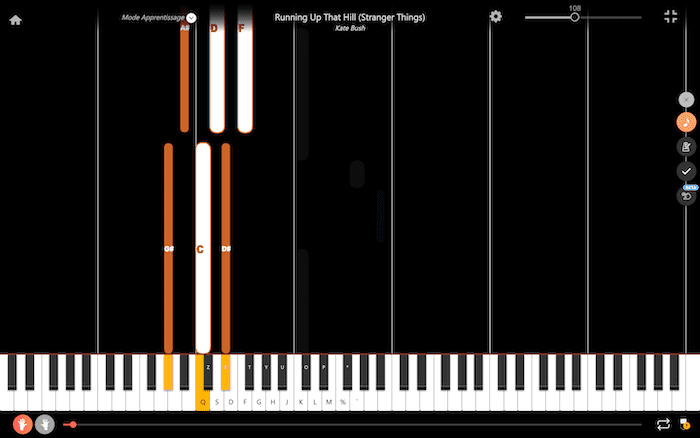
Running Up That Hill on the piano: the notes of the left hand.
As with the right hand, you can rely on our video tutorial to guide you through learning the left-hand notes for this famous song.
If you find that the speed of the notes is too fast, don’t hesitate to pause the video to take the time to position your fingers properly on the keyboard.
The La Touche Musicale app waits for you to play the correct note with your left hand on your piano before moving on to the next.
Well done! You’ve mastered the left-hand notes of Running Up That Hill on the piano!
Now let’s move on to the most exciting stage: playing this song with both hands simultaneously on the keyboard.
Here are a few tips for learning to play the piano with both hands simultaneously:
An important reminder: this exercise is a challenge, and the satisfaction of succeeding must be earned. If you don’t get it right the first time, don’t be discouraged! It’s perfectly normal and an integral part of the learning process.
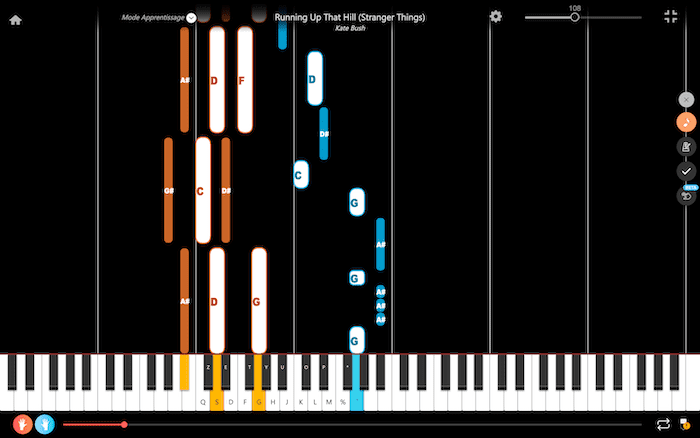
Running Up That Hill on the piano: the notes of both hands.
To boost your learning, our video tutorial is here to guide you in mastering the notes to be played with both hands simultaneously. You’ll then be able to interpret the melody and its accompaniment.
If you find that the speed of the notes is too fast, don’t hesitate to stop or slow down the video to take the time to position your fingers on the keyboard between each note.
To accompany you on this adventure, our interactive app La Touche Musicale can be an indispensable tool. It eliminates the need to stop the video manually, so you can concentrate on playing the notes. In learning mode, the application waits for you to play the right notes before moving on. It also lets you choose the note display version: Latin (Do, Ré, etc.) or Anglo-Saxon (C, D, etc.).
Ajoutez votre titre ici
The La Touche Musicale app waits for you to play the right notes with both hands on your piano before moving on to the next.
Magnificent performance! You’ve brilliantly played every note of Running Up That Hill on the piano with both hands!
If you enjoyed this tutorial, discover even more exciting content on our blog. We’ve put together this selection for you:
Mission accomplished thanks to this tutorial: you’re now able to perform one of the most inspiring songs from beginning to end on the piano, harmonizing both hands.
As a little bonus, we’ve included a link to download the score of Running Up That Hill in PDF format. You’re now free to play this piece wherever you are 😉 .
Don’t forget that for a learning experience that’s as enjoyable as it is instructive, our La Touche Musicale app is at your disposal. We invite you to discover its various features.
We look forward to accompanying you in future piano lessons!
Share the article on:
La Touche Musicale offers powerful AI apps to help you learn, play, and transcribe music effortlessly. Discover them below.
Ideal for: solo piano

Transcribe your piano pieces to sheet music with unrivalled precision.
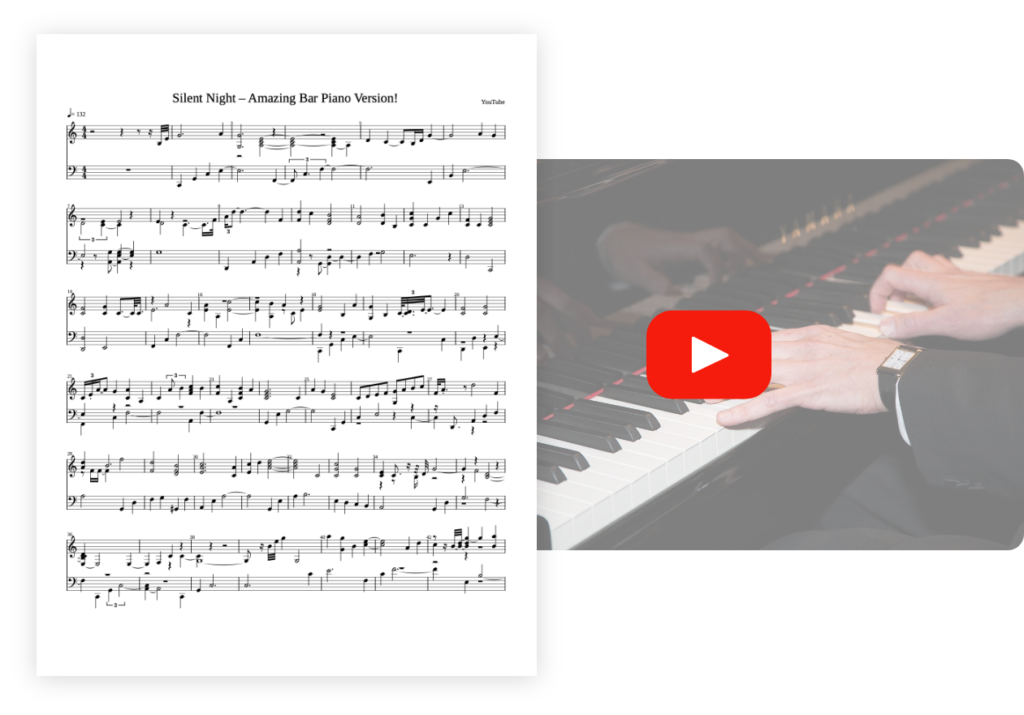
Ideal for: solo guitar

Transcribe your guitar tunes into tablature with unrivalled precision.
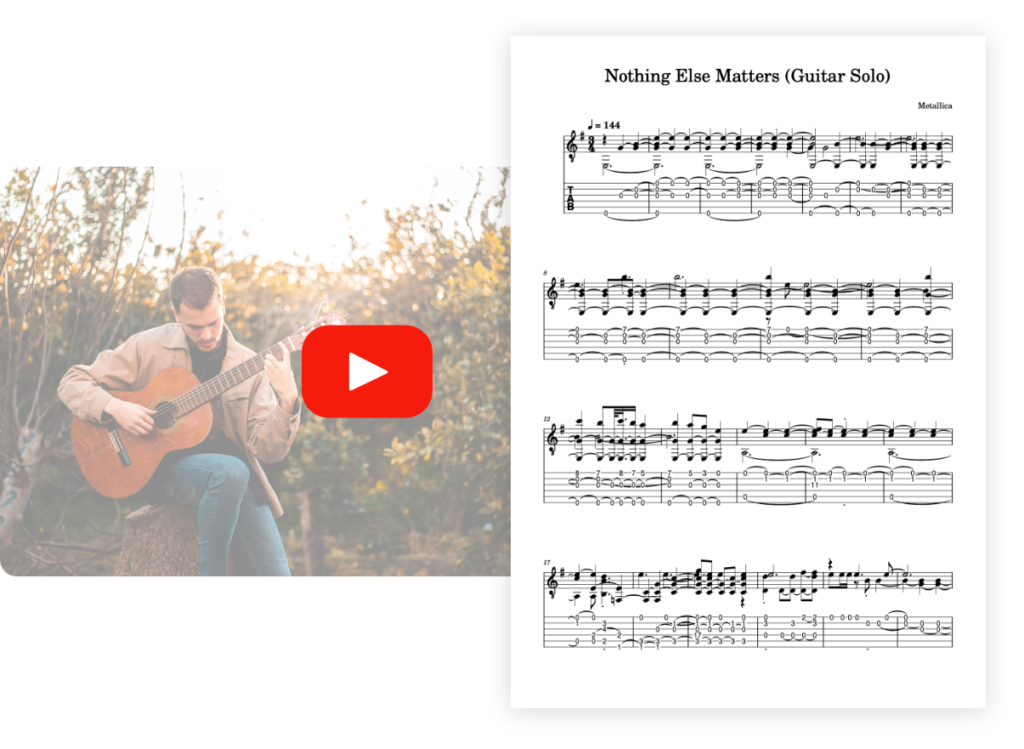
Ideal for: solo vocals

Transcribe your vocal recordings into sheet music with unrivalled precision.
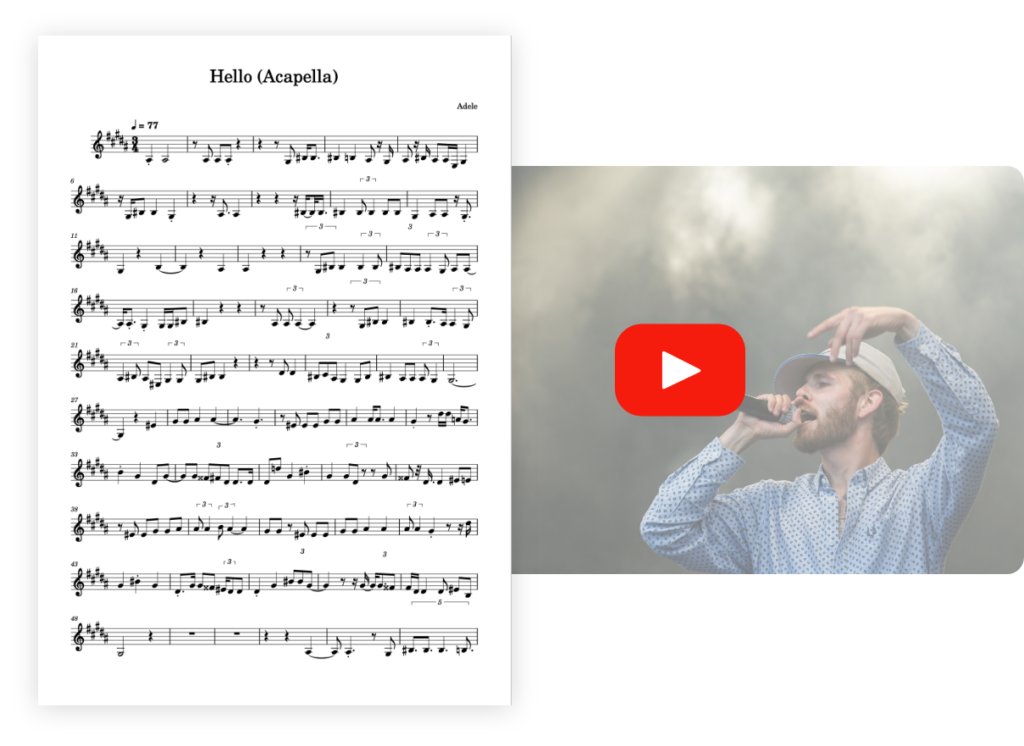
Ideal for: multi-instruments

Transcribe your multi-instrument tracks into sheet music with unrivalled precision.
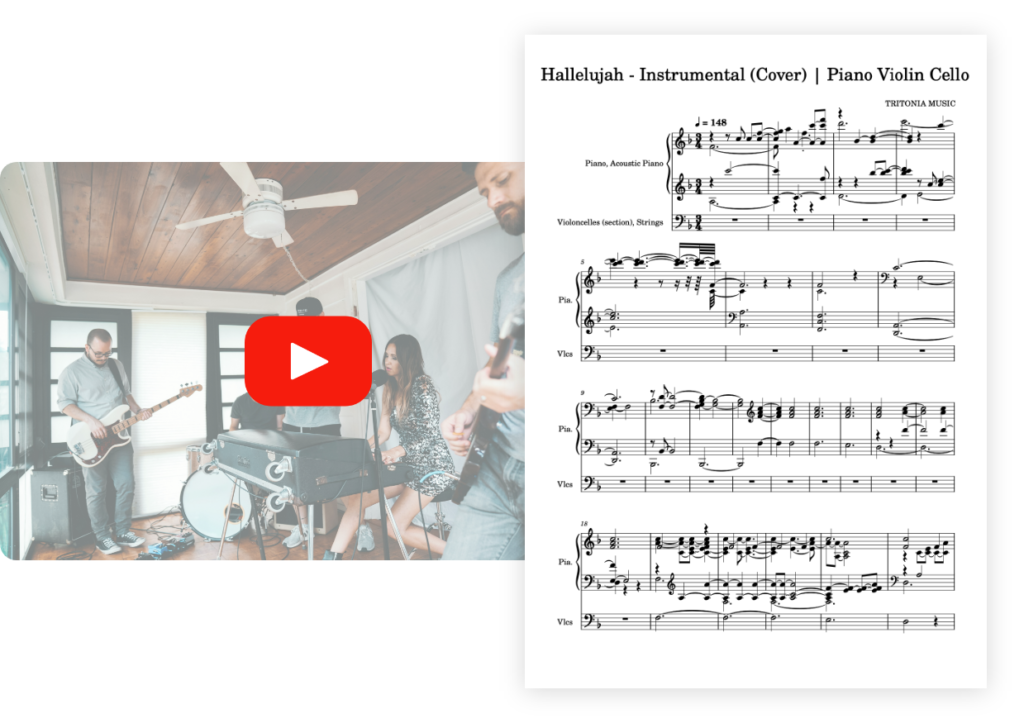
Ideal for: solo drums

Transcribe your drum tracks into sheet music with unrivalled precision.

Ideal for: solo violin

Transcribe your violin pieces into sheet music with unrivalled precision.
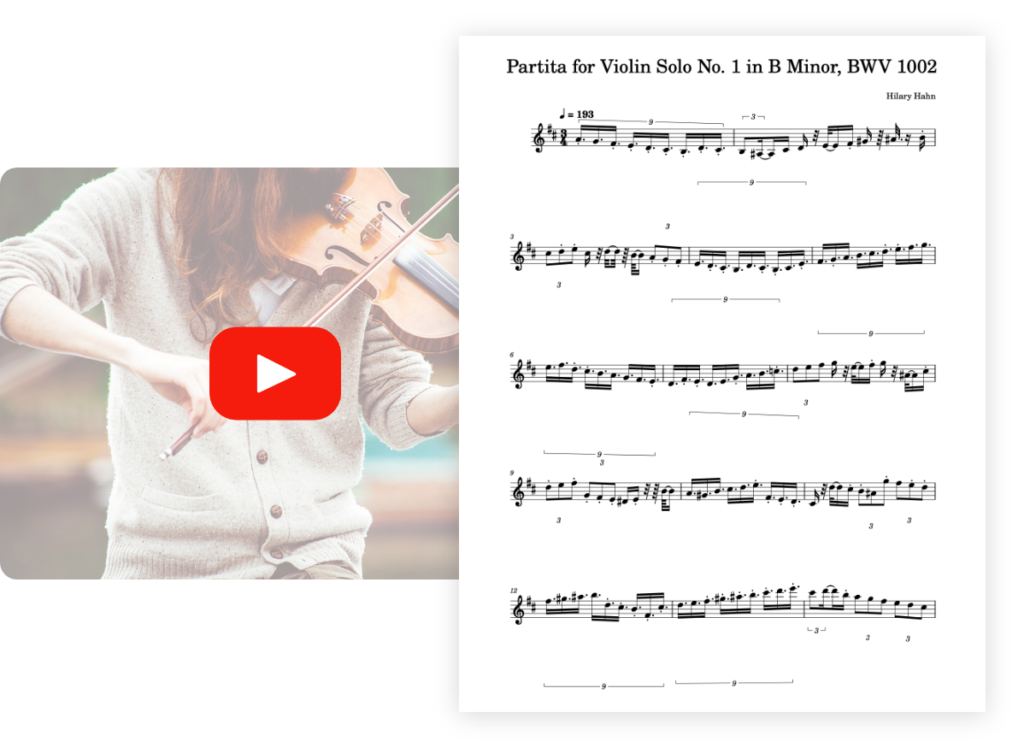
Optimized for: solo saxophone 🎷

Transcribe your saxophone pieces into sheet music with unrivaled precision.

Optimized for : solo flute 🪈

Transcribe your flute pieces into sheet music with unrivaled precision.
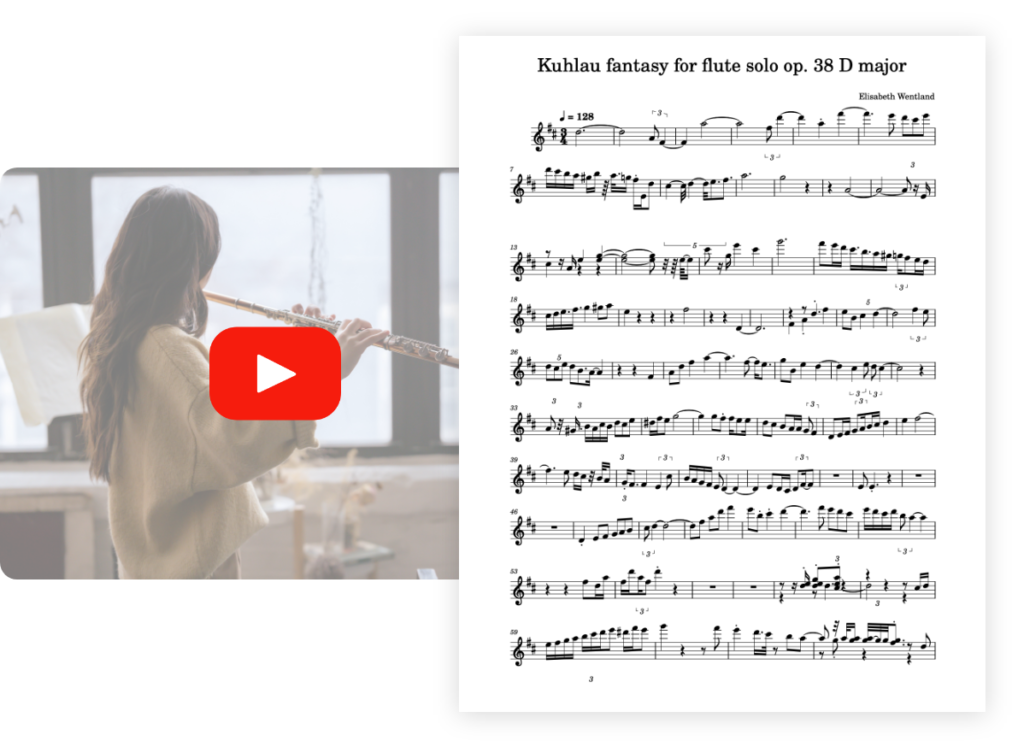
Optimized for : solo bass 🪕

Transcribe your bass pieces into sheet music with unrivaled precision.
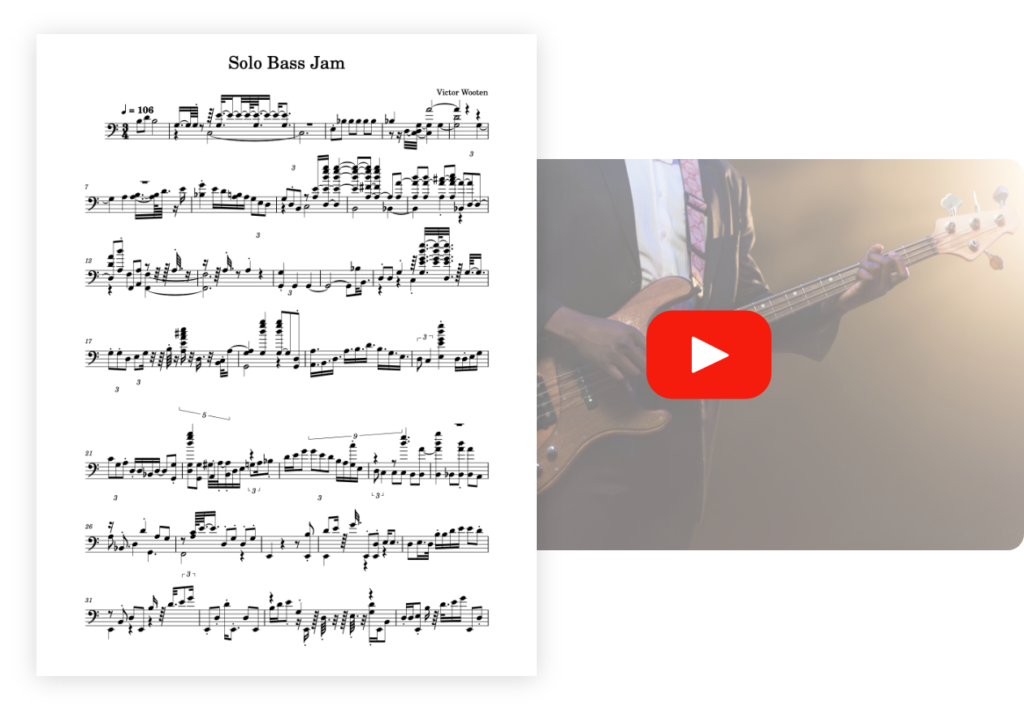
PianoGo lets you learn to play over 3,000 songs easily on the piano.
